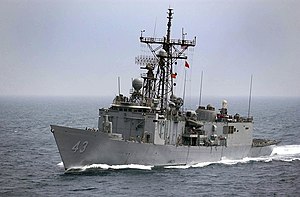
John Smith Thach was a World War II Naval Aviator, air combat tactician, and United States Navy admiral. Thach developed the Thach Weave, a combat flight formation which could counter enemy fighters of superior performance, and later the big blue blanket, an aerial defense against kamikaze attacks.
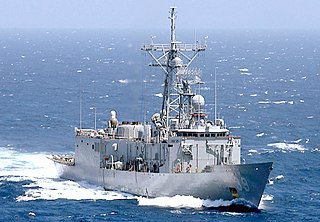
USS Doyle (FFG-39) was the 30th ship to be constructed in the Oliver Hazard Perry class of guided missile frigates of the United States Navy. Doyle was named after Vice Admiral James Henry Doyle (1897–1982). Vice Admiral Doyle was most known for his contributions during the Korean War as Commander Amphibious Group One. The ship was in service from 21 May 1983 to 29 July 2011. During her 28 years of service, Doyle went on at least six deployments to the Mediterranean Sea and two deployments to the Persian Gulf, including participation in Operation Earnest Will. The ship also operated in the Black Sea, Baltic Sea, and deployed to operate with the Middle East Force. Doyle took part in UNITAS 39-98. Deployed to the Standing Naval Forces Atlantic, and conducted three Southern Command Deployments.

USS Vandegrift (FFG-48) was an Oliver Hazard Perry-class frigate of the United States Navy. The ship was named for General Alexander A. Vandegrift (1887–1973), 18th Commandant of the Marine Corps.
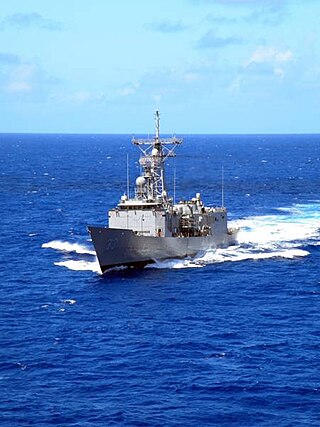
USS Jarrett (FFG-33), was the twenty-fifth ship of the Oliver Hazard Perry-class guided missile frigates, was named for Vice Admiral Harry B. Jarrett (1898–1974).

USS Crommelin (FFG-37), twenty-eighth ship of the Oliver Hazard Perry-class of guided-missile frigates, was named for five brothers: Rear Admiral John G. Crommelin (1902–1996), Vice Admiral Henry Crommelin (1904–1971), Commander Charles L. Crommelin (1909–1945), Lieutenant Commander Richard Crommelin (1917–1945), and Captain Quentin C. Crommelin (1919–1997). The Crommelin brothers were the only group of five siblings ever to graduate from the United States Naval Academy. Four of them became pilots, and Time magazine dubbed them "The Indestructibles." The brothers saw action in more than ten campaigns in the Pacific Theater. Henry, the second-oldest, became a Surface Warfare Officer while Richard and Charles died in combat as naval aviators in 1945. Individually and as a fighting family, they gained fame in World War II, attaining outstanding combat records and multiple decorations. Crommelin (FFG-37) is the first ship of that name in the United States Navy.

USS Samuel B. Roberts (FFG-58) is one of the final ships in the United States Navy's Oliver Hazard Perry-class of guided missile frigates (FFG). Commissioned in 1986, the ship was severely damaged by an Iranian mine in 1988, leading U.S. forces to respond with Operation Praying Mantis. Repaired and returned to duty, the ship served until decommissioned in 2015.
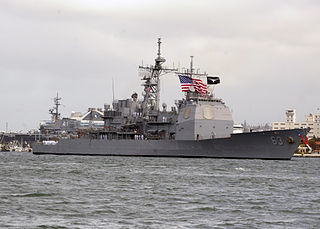
USS Cowpens (CG-63) is a Ticonderoga-class guided missile cruiser in service with the United States Navy. The ship is named after the Battle of Cowpens, a major American victory near Cowpens, South Carolina, in the American Revolution. She was built at the Bath Iron Works in Maine. Cowpens is stationed at Naval Base San Diego.
A destroyer squadron is a naval squadron or flotilla usually consisting of destroyers rather than other types of vessel. In some navies other vessels, such as frigates, may be included. In English the word "squadron" tends to be used for larger and "flotilla" for smaller vessels; both may be used for destroyer units. Similar formations are used in non-English-speaking countries, e.g., the "escadrille"—which would translate directly as "squadron"—in France.

Operation Prime Chance was a United States Special Operations Command operation intended to protect U.S.-flagged oil tankers from Iranian attack during the Iran–Iraq War. The operation took place roughly at the same time as Operation Earnest Will, the largely naval effort to escort the tankers through the Persian Gulf. The operation was begun after the mining of the U.S.-flagged Kuwaiti oil tanker Bridgeton.

USS Elrod (FFG-55), an Oliver Hazard Perry-class frigate, is a ship of the United States Navy named after Captain Henry T. Elrod (1905–1941), a Marine aviator who was posthumously awarded the Medal of Honor for his heroism in the defense of Wake Island in World War II.

USS Ford (FFG-54) was a Oliver Hazard Perry-class frigate in service with the United States Navy from 1985 to 2013. She was sunk as a target in the Pacific Ocean near Guam in 2019.

USS Gary (FFG-51) was an Oliver Hazard Perry-class frigate in the United States Navy. She was named for Medal of Honor recipient Commander Donald A. Gary (1903–1977).
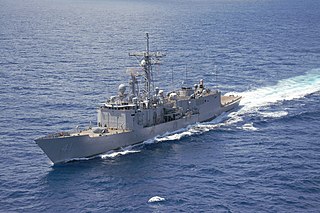
USS McClusky (FFG-41) was a Oliver Hazard Perry-class frigate of the United States Navy. She was named for Rear Admiral C. Wade McClusky (1902–1976) who as a lieutenant commander led the air group of USS Enterprise (CV-6), which sank the Japanese carriers Kaga and Akagi during the Battle of Midway. McClusky later served as part of Destroyer Squadron 1, and after 31 years of service, was decommissioned on 14 January 2015.
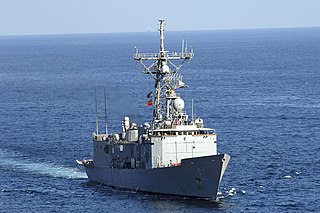
USS Ingraham (FFG-61), the last American Oliver Hazard Perry-class guided missile frigate to be built, was the fourth ship of the United States Navy to be named for Captain Duncan Ingraham (1802–1891).

Strike Fighter Squadron 97 (VFA-97) is a naval aviation squadron of the United States Navy. It is equipped with the F-35C Lightning II and is stationed at Naval Air Station Lemoore. The squadron is nicknamed "Warhawks" and it is currently assigned to Carrier Air Wing Two, tail code "NE". The squadron was originally established as Attack Squadron 97 (VA-97) on 1 June 1967 and redesignated VFA-97 on 24 January 1991.
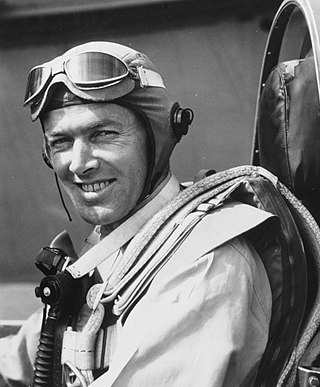
Vice Admiral James Henry Flatley Jr. was a World War II naval aviator and tactician for the United States Navy (USN). He became a fighter ace credited with shooting down six enemy aircraft in aerial combat.

Rear Admiral Richard Joseph Naughton was the superintendent of the U.S. Naval Academy from 2002 to 2003.
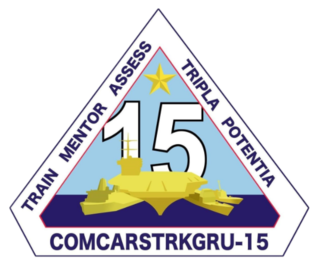
Carrier Strike Group 15, is a training formation of the United States Navy. It trains and certifies Pacific Fleet Carrier Strike Groups, Amphibious Ready Groups, and independently deploying surface ships. It replaced Commander, Strike Force Training Pacific in a title change. Carrier Strike Group Four is the equivalent command for US Fleet Forces ships.

Francis Xavier McInerney was a United States Navy vice admiral, Navy Cross recipient, Silver Star recipient and namesake of USS McInerney (FFG-8).

Helicopter Maritime Strike Squadron SEVEN EIGHT (HSM-78) "Blue Hawks" is a United States Navy helicopter squadron based at Naval Air Station North Island in San Diego, California. HSM-78 was established on 1 March 2012 and is currently assigned to "Team Broadsword" of Carrier Air Wing 2. The squadron operates the Sikorsky MH-60R Seahawk helicopter and deploys on ships assigned to the Carl Vinson Carrier Strike Group.
